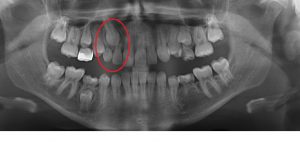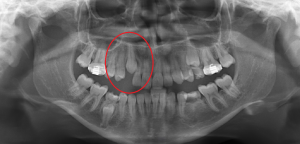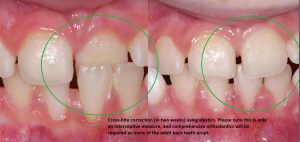Interceptive Orthodontics
Interceptive orthodontics maybe defined as orthodontic treatment to minimise or eliminate a developing orthodontic problem, so that the need for later treatment is either lessened or eliminated. It will be illustrated with two cases.
(a) Interception of a palatally displaced canine.
In approximately 2-3% of people the permanent canines (eye tooth) in the upper jaw can go off course.These ectopic teeth often need to be surgically exposed under general anaesthetic , and then brought into the arch orthodontically. If this can be detected by clinical and radiographic examination at approximately 9- 10 years of age the canines which have gone off course and are inside the arch can be corrected in a significant number of cases by extracting the deciduous (baby) canine. Sometimes as well as extracting the deciduous ( baby) canine tooth , it is better to also create space for the larger permanent tooth, possibly with headgear or another appliance.This may avoid the surgical exposure of the canine under general anaesthetic , and avoid or simplify the subsequent orthodontic treatment.
This radiograph (and others not shown) shows that the upper right permanent canine is ectopic (out of line) and is on the inside of the lateral incisor . The deciduous canine was extracted and extra space in the arch provided with headgear.
The position of the upper right permanent canine improved. This is an example of interceptive orthodontics.
(b) Correction of anterior crossbite.
Sometimes an anterior cross-bite can be corrected in two weeks using elastics if there is sufficient space for the tooth to straighten up. This is only done as a quick interceptive measure from age 7-8 onwards. It will not (obviously ) eliminate the need for comprehensive treatment later. This brief (2 weeks ) treatment maybe performed for the following reasons.
(1) Patient/ Parent doesn’t like the appearance of the crossbite.
(2) It maybe associated with a forced forwards shift of the lower jaw (mandibular displacement).
(3) Sometimes the lower incisor (tooth) can be pushed forwards (to an extent) out of the lower jaw and get some gingival recession (the gum falls off the front of the lower tooth ).
(4) Sometimes one or both of the teeth in the cross-bite get excessive tooth wear.
This is an example of interceptive orthodontics.
In Clonmel orthodontics we routinely practise these and other interceptive orthodontic procedures.
…………………………………………………………………………………………………………………………………………………
(Clonmel Orthodontics blogs are intended to be factual rather than aspirational or for purely marketing purposes)
This orthodontic blog was written by Dr John Buckley,who is a specialist orthodontist at Clonmel Orthodontics in Clonmel County Tipperary, Ireland.He is both Clonmel’s most qualified and most experienced orthodontist.
Clonmel Orthodontics provides orthodontics to county Tipperary and the neighbouring counties of Waterford, Kilkenny, Limerick,Cork , and beyond.
Dr Buckley has practised as a specialist orthodontist in Clonmel for over 20 years. In addition to his orthodontic qualifications which he held before he commenced orthodontic practice , Dr Buckley was awarded a First class masters degree in Lingual orthodontics from the University of Hannover medical school (MHH) in 2012. This masters degree is directed by Professor Dirk Wiechmann who is the inventor of both the incognito™ and win™ lingual appliances. Dr Buckley was the first orthodontist in Ireland to be awarded this qualification. In 2016 he was accepted as an active member of the European Society Of Lingual Orthodontics (ESLO). To become an active member it is necessary for candidates to submit the records of finished lingual cases. If the cases are deemed to be of a sufficiently high standard then the candidate is accepted as an active member of ESLO. Dr Buckley is the first and only orthodontist in Ireland to be accepted as an active member of ESLO.




